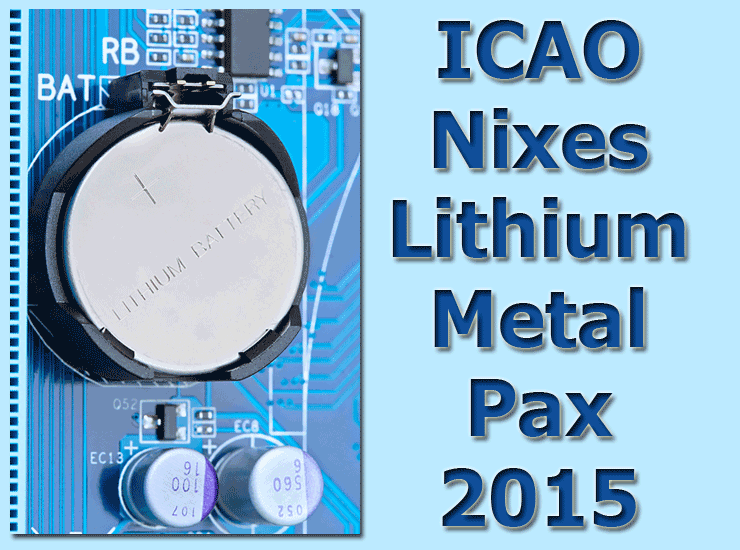
The
ICAO Dangerous Goods Panels (DGP) working group studying Lithium batteries
that convened in Montreal from April 7th to 11th has come down with a
decision to ban transport of Lithium Metal batteries, shipped aboard passenger
carrying aircraft.
Effective January
1st, 2015 when a new ICAO Biennium will begin and a new
edition of the international legal framework for the transport of Dangerous
Goods by Air, the “ICAO Technical Instructions for the Safe Transport
of Dangerous Goods by Air” will go into force now promising a new
deal for Lithium batteries.
The decision of the DGP still requires approval
from two ICAO governing bodies, the Air Navigation Commission (ANC) and
the ICAO Council.
While it is expected that both the ANC and the
Council will approve the DGP’s decision, one should not take such
approval for granted, especially in the light of considerable industry
lobbying from organizations such as NEMA (National Electrical Manufacturers
Association and PRBA (The Rechargeable Battery Association).
Li-Batteries for Dummies
There are basically two types of Lithium batteries:
Primary (Lithium – Metal) and Secondary (Lithium – Ion). Lithium
Polymer batteries are classified Lithium – Ion type.
These two types must be differentiated since
the danger level of each differs greatly. The main issue is that Lithium
Metal batteries are considered to be more volatile and that they exhibit
a burn temperature of about 1450 degrees Celsius; and that the fire suppressant
used aboard aircraft, Halon, has proven ineffective against lithium metal
battery fires.
The two types of batteries, Lithium metal (UN
3090) and Lithium – Ion (UN 3480) each come in three different forms:
The batteries as such, batteries packed with equipment and batteries contained
in equipment.
Each battery type has different packaging instructions
featuring unique requirements which must be complied with.
The packaging instructions for batteries included
with and contained in equipment are each divided into two parts:
Part II are small cells or batteries.
For Lithium Metal batteries, the limit is 1g
of aggregate Lithium per cell and 2 g per battery; for Lithium –
Ion batteries the threshold is 20 Wh per cell and 100 Wh per battery.
Currently, small batteries in compliance with
the limitations of part II of the applicable packing instruction can be
transported without a formal transport document (the “Shipper’s
Declaration for Dangerous Goods”), they do not need a specific packaging
(although the packaging must have undergone a drop test and a stack test).
They are exempt from most of the formal DG requirements,
including the requirement for formal DG training of the shipper’s
staff.
For the batteries shipped as such, there are
actually three parts in the applicable packing instructions, Part IA,
Part IB and Part II. When a battery or cell is of the “small”
type but the quantity limitations stipulated by the applicable PI are
not complied with, these batteries can be shipped under Part IB with a
Shipper’s Declaration up to 10kg gross mass per package for Li-Ion
batteries and 2.5 kg gross mass for Lithium Metal batteries.
In this context, it does not help that quantity
limitation in parts IA and II are net article weight limitations and for
part IB gross mass limitations, owing to some ruckus within the ICAO DGP,
the group which approved this decision about one year ago.
If you feel that this background information
is complicated, welcome to the club, but bear in mind that PRBA and NEMA
are outspoken advocates of no formal DG training necessary for shippers
of the “small” types.
Issue
often overlooked
The main culprit however is that any battery,
no matter which type and form – including the small button-type
cells in your watch, as well as lithium – Ion battery packs in your
electrical bicycle or power drill – must have successfully undergone
a test in accordance with part III, subsection 38.3 of the UN manual of
Tests and criteria.
It is the responsibility of any and all shippers
to have either the full test certificate or at least a so-called “certificate
of conformity” on hand so that, at least theoretically, the conformity
of the batteries to be shipped with the so-called “general requirements”
can be proven.
Suffice it to say that such a certificate is
mostly unavailable, and even dedicated and compliant shippers will find
it hard to impossible to come across the required documentation:
Very often, manufacturers of equipment that contain
Lithium batteries are sourcing identical cells and batteries from different
manufacturers and are unable to tell which battery has been installed
in which particular device.
What will
change?
The ICAO DGP’s decision, if enacted and
approved, will do away with part II of Packing Instruction 968 which covers
Lithium Metal batteries and cells.
As the discussion paper so aptly put it, “continuing
to permit their transport on passenger-carrying aircraft, despite the
known risks should not be considered an acceptable mitigation strategy.”
This will only cover the shipment of Lithium
metal batteries.
When installed in or shipped with equipment,
Lithium metal batteries will still be permitted on passenger aircraft.
This means that Lithium Metal batteries will
need to be shipped by all-cargo aircraft or by ground – which given
the demise of all-cargo operators in some parts of the world and the viability
of operating all-cargo aircraft in a market with constantly declining
yields may be an issue.
What
will come of it?
Indeed a very valid question is whether shippers
might not adopt an avoidance strategy and decide to ship these batteries
undeclared (which is actually the greatest risk of all), since for Dangerous
Goods not declared as such, there are little, if any, mitigation strategies.
Subsequently, the ICAO DGP paper while expressing
“concern that such ban on the transport of lithium metal batteries
(on passenger-carrying aircraft) would increase the risk as it would serve
only to stop compliant shipments of batteries and that non-compliant (means:
undeclared) shipments would continue and likely increase in number”
is of the opinion that “most citizens and organizational entities
are known to be law abiding and do not violate restrictions or prohibitions.”
The latter may be wishful thinking, since the
UPS 006 accident could be used to argue otherwise.
Not
the End
The decision of the ICAO DGP, however, even if
approved and enacted is hardly the end. The issue of flight UPS 006 came
up, we are told, numerous times during the DGP meeting, but was rebuffed
because UPS 006 was an all-cargo aircraft. However, the undeclared batteries
which most likely started the fire in the UPS 006 cargo hold could have
been loaded aboard a passenger aircraft as well. It was sheer luck that
they weren’t. Since these goods were not declared as dangerous goods,
there was nothing prohibiting their transport aboard a passenger-carrying
aircraft.
Test
Played Into Decision
The background scenario for the ICA DGP decision
was a multidisciplinary meeting hosted by the FAA’S William J. Hughes
Technical Centre from February 4th to February 6th this year. FAA was
able to prove that the postulations made as a result of their cargo aircraft
fire risk model, which PRBA had called “faulty and flawed”
were actually too conservative:
4,800 lithium-metal 123A cells were loaded in
their original shipping cartons into a 727 cargo airliner donated by FedEx.
A small alcohol fire was used to start the fire.
*The fire in the class C lower cargo hold could not be controlled with
Halon 1301.
* The test had to be halted after nine minutes after the fire would have
been detected to prevent the loss of the test airframe.
* After halting the test, an explosion occurred that blew the flight deck
door off its hinges, dislodged all of the main deck flooring above (…).
*The test produced temperatures in the cargo hold which exceeded the certification
requirements for cargo liners and caused smoke propagation into the flight
deck. Within five minutes of fire detection, the flight deck was fully
obscured by smoke (the UPS 006 accident scenario). The low ventilation
rate and reduced oxygen concentration had little effect in containing
the fire”.
The aforementioned findings are quoted from the
ICAO DGP working paper 1 that states in conclusion:
“The outcome of the analysis suggested
the transport of lithium metal batteries on passenger aircraft posed an
unacceptable risk under the existing circumstances, on the basis that
the likelihood of an event occurring was remote, but that the severity
of the consequence of the event would be catastrophic.”
What’s
next?
ICAO DGP will meet again in November this year,
and then the question of how to deal with Lithium metal batteries aboard
all-cargo aircraft. Likely, there will be further restrictions and limitations.
It should be said clearly that there are transport
solutions, which can indeed mitigate the risks associated with lithium
batteries of any type. For example, the IntuPlas containers of PyroPhobic
Systems have proven effective in containing Lithium battery fires –
even those of the Lithium metal variety – over a prolonged period
of time, so in case service to shipping destination by cargo aircraft
is not available, and ground transport proves too slow, there are options,
since almost anything may be transported legally with competent authority
approval under the conditions laid out by such authority.
Whatever the course of action, myriads of employees
worldwide required to undergo either initial or recurrent DG training
will struggle with the annual re-do of the Lithium battery shipping requirements,
and so will the shippers.
Jens |


